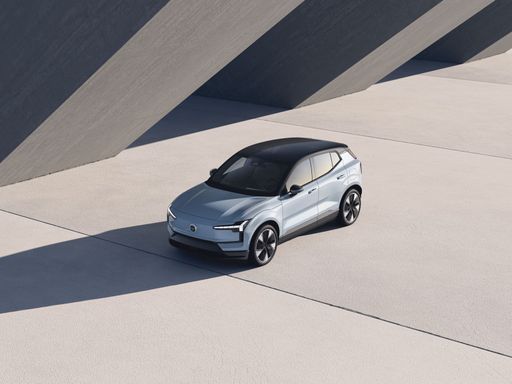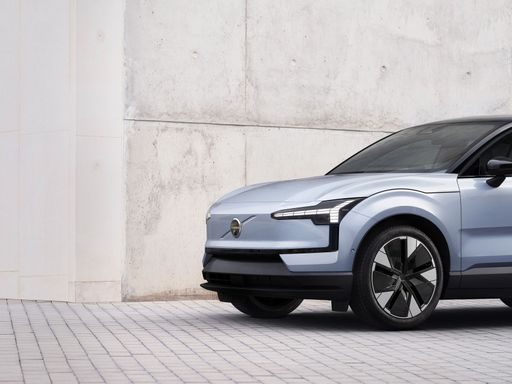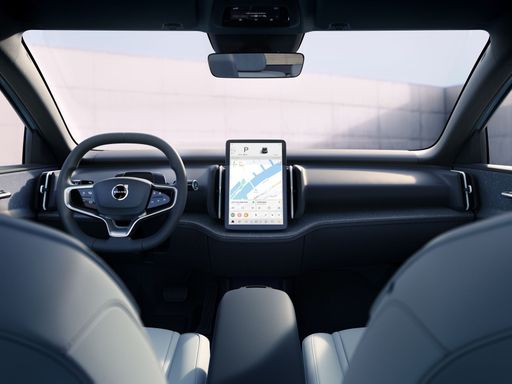Mercedes Sprinter Transporter VS Volvo EX30 – Specs, Efficiency & Price Comparison
Which model is the better choice – the Mercedes Sprinter Transporter or the Volvo EX30? We compare performance (204 HP vs 428 HP), boot capacity ( vs 318 L), efficiency (27.10 kWh7.90 L vs 17 kWh), and of course, the price (26900 £ vs 34100 £).
Find out now which car fits your needs better!
The Mercedes Sprinter Transporter (Cargo Van) is powered by a Electric or Diesel engine and comes with a Automatic or Manuel transmission. In comparison, the Volvo EX30 (SUV) features a Electric engine and a Automatic gearbox.
When it comes to boot capacity, the Mercedes Sprinter Transporter offers , while the Volvo EX30 provides 318 L – depending on what matters most to you. If you’re looking for more power, you’ll need to decide whether the 204 HP of the Mercedes Sprinter Transporter or the 428 HP of the Volvo EX30 suits your needs better.
There are also differences in efficiency: 27.10 kWh7.90 L vs 17 kWh. In terms of price, the Mercedes Sprinter Transporter starts at 26900 £, while the Volvo EX30 is available from 34100 £.
Compare all the key specs now and find out which model fits your lifestyle best!
Mercedes Sprinter Transporter
The Mercedes-Benz Sprinter Transporter is renowned for its versatility and reliability, making it a popular choice for businesses across various industries. Featuring a spacious and intelligently designed interior, it offers ample cargo space while ensuring comfort for the driver. With a reputation for durability and advanced technology, the Sprinter continues to set standards in the commercial vehicle sector.
detailsVolvo EX30
The Volvo EX30 represents a bold step forward for the brand, combining advanced technology with sustainable design principles. Its sleek and compact exterior belies a spacious interior that offers a premium driving experience. With a focus on safety and innovation, this model reflects Volvo's commitment to shaping the future of urban mobility.
details @ Volvo
@ Volvo
 @ Volvo
@ Volvo
 @ Volvo
@ Volvo
 @ Volvo
@ Volvo
 @ Volvo
@ Volvo

|
|
|
|
|
Costs and Consumption |
|
|---|---|
|
Price
26900 - 72900 £
|
Price
34100 - 49100 £
|
|
Consumption L/100km
7.9 - 12.7 L
|
Consumption L/100km
-
|
|
Consumption kWh/100km
27.1 - 31.5 kWh
|
Consumption kWh/100km
17 - 18.7 kWh
|
|
Electric Range
194 - 444 km
|
Electric Range
339 - 476 km
|
|
Battery Capacity
56 - 113 kWh
|
Battery Capacity
49 - 65 kWh
|
|
co2
0 - 333 g/km
|
co2
0 g/km
|
|
Fuel tank capacity
71 L
|
Fuel tank capacity
-
|
Dimensions and Body |
|
|---|---|
|
Body Type
Cargo Van
|
Body Type
SUV
|
|
Seats
3
|
Seats
5
|
|
Doors
4
|
Doors
5
|
|
Curb weight
2052 - 3166 kg
|
Curb weight
1840 - 1983 kg
|
|
Trunk capacity
-
|
Trunk capacity
318 L
|
|
Length
5932 - 7367 mm
|
Length
4233 mm
|
|
Width
1993 mm
|
Width
1837 mm
|
|
Height
2331 - 2663 mm
|
Height
1549 - 1567 mm
|
|
Payload
577 - 2641 kg
|
Payload
352 - 390 kg
|
Engine and Performance |
|
|---|---|
|
Engine Type
Electric, Diesel
|
Engine Type
Electric
|
|
Transmission
Automatic, Manuel
|
Transmission
Automatic
|
|
Transmission Detail
Schaltgetriebe, Automatikgetriebe
|
Transmission Detail
-
|
|
Drive Type
Rear-Wheel Drive, All-Wheel Drive
|
Drive Type
Rear-Wheel Drive, All-Wheel Drive
|
|
Power HP
114 - 204 HP
|
Power HP
272 - 428 HP
|
|
Acceleration 0-100km/h
-
|
Acceleration 0-100km/h
3.6 - 5.7 s
|
|
Max Speed
90 km/h
|
Max Speed
180 km/h
|
|
Torque
300 - 450 Nm
|
Torque
343 - 543 Nm
|
|
Number of Cylinders
4
|
Number of Cylinders
-
|
|
Power kW
84 - 150 kW
|
Power kW
200 - 315 kW
|
|
Engine capacity
1950 cm3
|
Engine capacity
-
|
General |
|
|---|---|
|
Model Year
2024 - 2025
|
Model Year
2024 - 2025
|
|
CO2 Efficiency Class
A, G
|
CO2 Efficiency Class
A
|
|
Brand
Mercedes-Benz
|
Brand
Volvo
|
Mercedes Sprinter Transporter
The Evolution of the Mercedes-Benz Sprinter Transporter
The Mercedes-Benz Sprinter has been a staple in the commercial vehicle sector for decades, known for its reliability, versatility, and impressive load capacity. The latest iterations, including the fully electric eSprinter variants, demonstrate Mercedes-Benz's commitment to innovation and sustainability. These vehicles are designed to meet the needs of various business applications, providing numerous options to cater for all logistical demands.
Electrification and Engine Options
The Mercedes-Benz Sprinter Transporter offers a wide range of engine choices, from traditional diesel engines to state-of-the-art electric powertrains. Diesel options are available in capacities ranging from 114 PS to 190 PS, providing durable performance for long hauls while maintaining decent fuel efficiency, with consumption between 7.9 and 12.7 litres per 100 km. The electric eSprinter, on the other hand, boasts an output of either 136 PS or 204 PS, with a consumption of about 26.3 to 30.7 kWh per 100 km, and offers a range of up to 453 km depending on the battery size.
Technical Specifications and Safety Features
The Sprinter Transporter carries a diverse set of technical options to enhance both functionality and safety. The models are equipped with either manual or automatic transmissions, with choices in rear-wheel drive or all-wheel drive options. The eSprinter highlights innovative features such as regenerative braking and a robust electric motor delivering up to 450 Nm of torque.
On the safety front, the Sprinter includes features such as active distance assist, blind spot assist, and lane-keeping assist to ensure maximum security for drivers and goods alike.
Dimensions and Payload Capabilities
Designed for versatility, the Sprinter Transporter showcases various configurations in terms of dimensions and payload capacities. Lengths range between 5932 mm to 7367 mm, widths settle at 1993 mm, and heights vary from 2331 mm to 2663 mm, accommodating a range of business needs. With a payload capability of up to 2641 kg, the Sprinter is well suited for heavy-duty tasks, offering ample load volume and accessibility.
Inside the eSprinter Experience
Stepping into the eSprinter offers an advanced driving experience, tailored to the demands of modern day logistics. The electric variants include new telematics systems for fleet management, offering remote diagnostics and optimised communication between vehicles and back-office operations. Moreover, features such as a user-friendly cockpit, comfortable seating, and advanced climate control mirror the premium standards of Mercedes-Benz, ensuring drivers enjoy every aspect of their journey.
Conclusion: Mercedes-Benz Sprinter Leads the Charge
The Mercedes-Benz Sprinter remains at the forefront of the commercial vehicle market, offering a blend of power and innovation across its diesel and electric models. With its forward-thinking technology, the eSprinter sets new standards in environmental stewardship without compromising on performance or utility. It is an excellent choice for businesses looking to transition to more sustainable transport solutions while benefiting from the reliability and quality that Mercedes-Benz is known for.
Volvo EX30
Unveiling the Volvo EX30
The automotive world is buzzing with excitement over the release of Volvo's latest electric vehicle: the Volvo EX30. This all-new addition to Volvo's lineup showcases the company's commitment to sustainability and innovation in the world of SUVs. Designed with precision and equipped with cutting-edge technology, the Volvo EX30 offers a compelling blend of performance, efficiency, and advanced features.
Technical Mastery Under the Hood
The Volvo EX30 comes with a range of powertrains to suit different driving preferences. Consumers can choose between the Single Motor and Twin Motor variants, with power outputs ranging from an impressive 272 PS to a robust 428 PS. The Twin Motor Performance version guarantees thrilling acceleration, reaching 0-100 km/h in just 3.6 seconds, making it one of the quickest electric SUVs available.
The EX30's efficiency is equally noteworthy, with an energy consumption rate starting at just 17 kWh/100km. Coupled with a battery capacity ranging from 49 to 65 kWh, this vehicle offers an impressive electric range spanning between 339 km and 476 km, depending on the chosen configuration.
Innovative and Sustainable Design
Volvo continues its quest for sustainability with the EX30, as evidenced by its zero CO2 emissions, contributing to a cleaner environment. The car's design prioritises both environmental consciousness and modern aesthetics, featuring recycled materials in its construction, without compromising on luxury or style.
Inside the cabin, the EX30 provides comfort and sophistication for up to five passengers, ensuring ample space and modern conveniences. The cabin's focus on ergonomics and understated luxury ensures that every journey is a pleasure.
Safety and Technology at Its Core
As with all Volvo vehicles, safety is paramount. The EX30 is no exception, equipped with an array of advanced safety features including state-of-the-art driver assistance systems to ensure maximum security on the road.
Furthermore, the vehicle's infotainment system is designed to provide seamless connectivity and entertainment options for the tech-savvy driver. The integration of intuitive controls and a responsive interface makes operating the vehicle's features an effortless experience.
Conclusion
The Volvo EX30 sets a new benchmark for electric SUVs, combining impeccable performance with sustainability and innovation. With a competitive price range of €39,790 to €55,290, this vehicle offers excellent value for those looking to embrace the future of motoring. Whether it's the cutting-edge technology, thrilling performance, or eco-conscious design, the Volvo EX30 is poised to become a leader in the electric vehicle market.
The prices and data displayed are estimates based on German list prices and may vary by country. This information is not legally binding.
